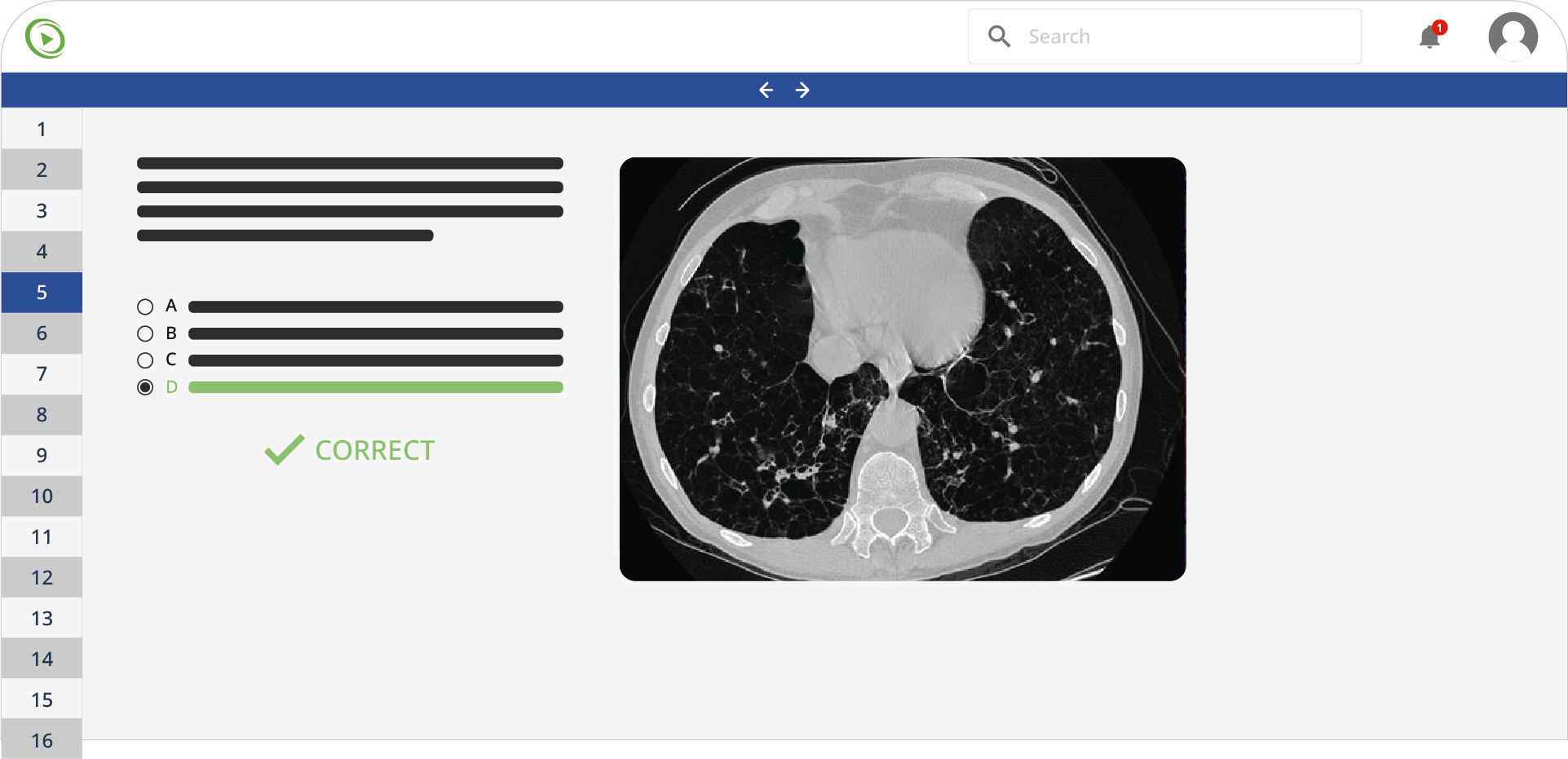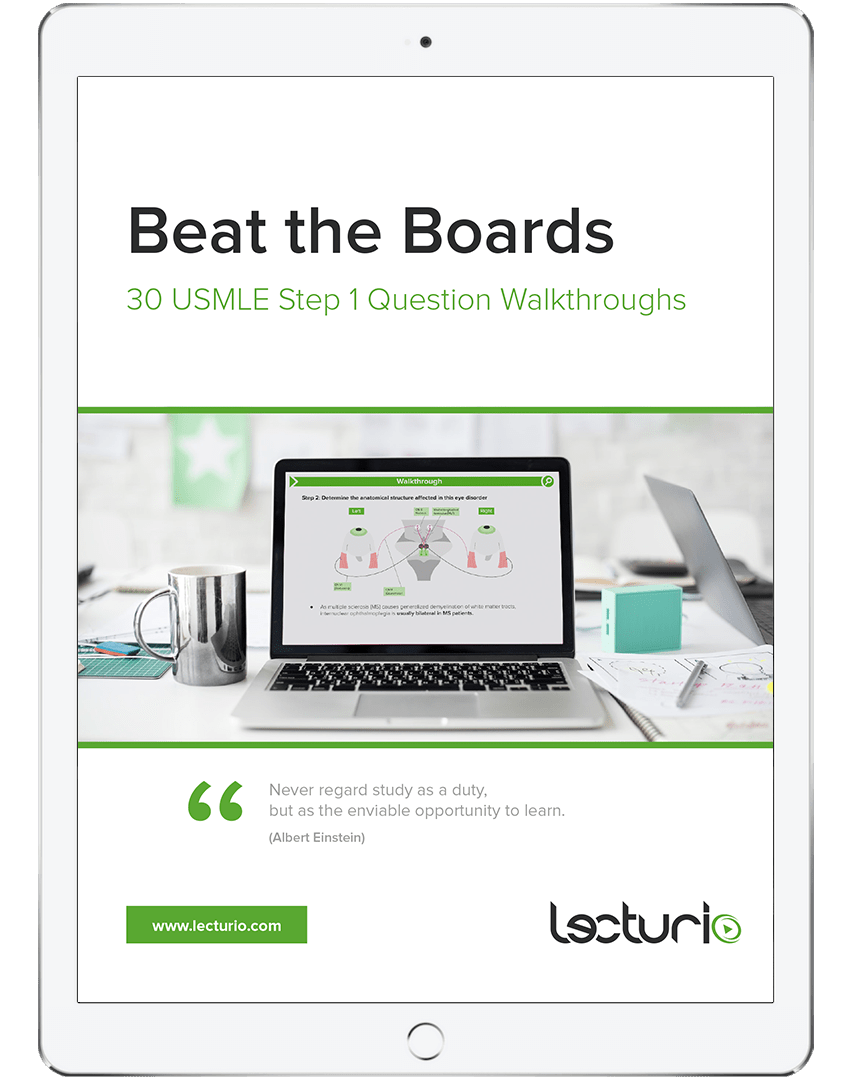A 55-year-old man presents with fever, chills, fatigue, cough, sore throat, and breathlessness for the past 7 days. He describes the cough as productive and says he is fatigued all the time. He says he is a farmer with daily contact with rabbits, horses, sheep, pigeons, and chickens and reports cleaning the barn 3 days before his symptoms started. The patient denies any history of tick bites. Past medical history is irrelevant. His temperature is 39.4°C (103.0°F), the pulse is 110/min, and the respirations are 26/min. On physical examination, there are decreased breath sounds on the right side. A large tender node is palpable in the right axilla. A chest radiograph reveals multiple homogenous opacities in the lower lobe of the right lung and right-sided pleural effusions. Gram staining of a sputum sample is negative for any organism. Serology tests are negative. Which of the following is the most likely causative organism for this patient’s condition?
A. Francisella tularensis
B. Bacillus anthracis
C. Staphylococcus aureus
D. Yersinia pestis
E. Mycoplasma pneumoniae
A 50-year-old man presents to the office with complaints of fever and chills for 4 weeks. He adds that he is fatigued all the time and has a generalized weakness. He has drenching night sweats and has had 2 episodes of non-bilious vomiting over the past few days. He traveled to the Netherlands for 4 days a month ago. His symptoms started a few days after he returned home. Laboratory testing revealed the following:
| Hemoglobin | 11.2 g/dL |
| Hematocrit | 29% |
| Leukocyte count | 2,950/mm3 |
| Neutrophils | 59% |
| Bands | 3% |
| Eosinophils | 1% |
| Basophils | 0% |
| Lymphocytes | 31% |
| Monocytes | 4% |
| Platelet count | 60,000/mm3 |
| Unconjugated bilirubin | 12 mg/dL |
| Alanine aminotransferase | 200 IU/L |
| Aspartate aminotransferase | 355 IU/L |
The peripheral blood smear showed basophilic ring- and pear-shaped structures inside many red cells and extracellular basophilic rings on Wright-Giemsa staining. Further evaluation revealed parasitemia and a few schistocytes, poikilocytes, and merozoites in tetrad formation. The findings are most consistent with which diagnosis?
A. Malaria
B. Babesiosis
C. Anaplasmosis
D. Tuberculosis
E. Lyme disease
A 27-year-old man who recently emigrated as a refugee from Somalia presents with fever, weight loss, fatigue, and exertional chest pain. He says his symptoms began 3 weeks ago and that his appetite has decreased and he has lost 3 kg (6.6 lb) in the last 3 weeks. He denies any history of cardiac disease. His past medical history is unremarkable. The patient admits that he has always lived in poor hygienic conditions in overcrowded quarters and in close contact with cats. His vital signs include: blood pressure 120/60 mm Hg, pulse 90/min, and temperature 38.0°C (100.4°F). Physical examination reveals generalized pallor. A cardiac examination reveals an early diastolic murmur loudest at the left 3rd intercostal space. Abdominal examination reveals a tender and mildly enlarged spleen. Prominent axillary lymphadenopathy is noted. Laboratory investigations reveal a WBC count of 14,500/μL with 5% bands and 93% polymorphonuclear cells. An echocardiogram reveals 5-mm vegetation on the aortic valve with moderate regurgitation. Three sets of blood cultures are taken over 24 hours followed by empiric antibiotic therapy with gentamicin and vancomycin. The blood cultures show no growth after 5 days. Following a week of empiric therapy, the patient continues to deteriorate. Which of the following would most likely confirm the diagnosis in this patient?
A. Bartonella serology
B. Q fever serology
C. Peripheral blood smear
D. HIV polymerase chain reaction
E. Epstein-Barr virus heterophile antibody
A 38-year-old man complains of a persistent high fever with chills, malaise, and diffuse abdominal pain for over a week. He recently returned from a trip to India. The fever began slowly and increased to 40.0°C (104.0°F) over the last 4 days. A physical exam reveals a white-coated tongue, enlarged spleen, and rose-colored spots on the abdomen. A bone marrow aspirate was sent for a culture that revealed motile gram-negative rods. Which of the following is true about the organism and the pathophysiology underlying this condition?
A. It forms blue-green colonies with a fruity odor.
B. It survives intracellularly within phagocytes of Peyer’s patches.
C. Splenectomy may be necessary for carriers.
D. Incidence increases after cholecystectomy. chain reaction
E. It releases a toxin which inactivates 60S ribosomes.
A 29-year-old woman presents with a skin rash that has spread on her arm over the last few days. She also complains of fever, headache, joint pain, and stiffness of the neck associated with the onset of the rash. On physical examination, there is an annular, red rash with a clear area in the center similar to a bull’s-eye (see image). The patient says she went on a camping trip to Connecticut last month but does not remember being bitten by an insect. Which of the following could result if this condition remains untreated in this patient?
A. Necrotizing fasciitis
B. Bell’s palsy
C. Pseudomembranous colitis
D. Subacute sclerosing panencephalitis
E. Mitral valve prolapse
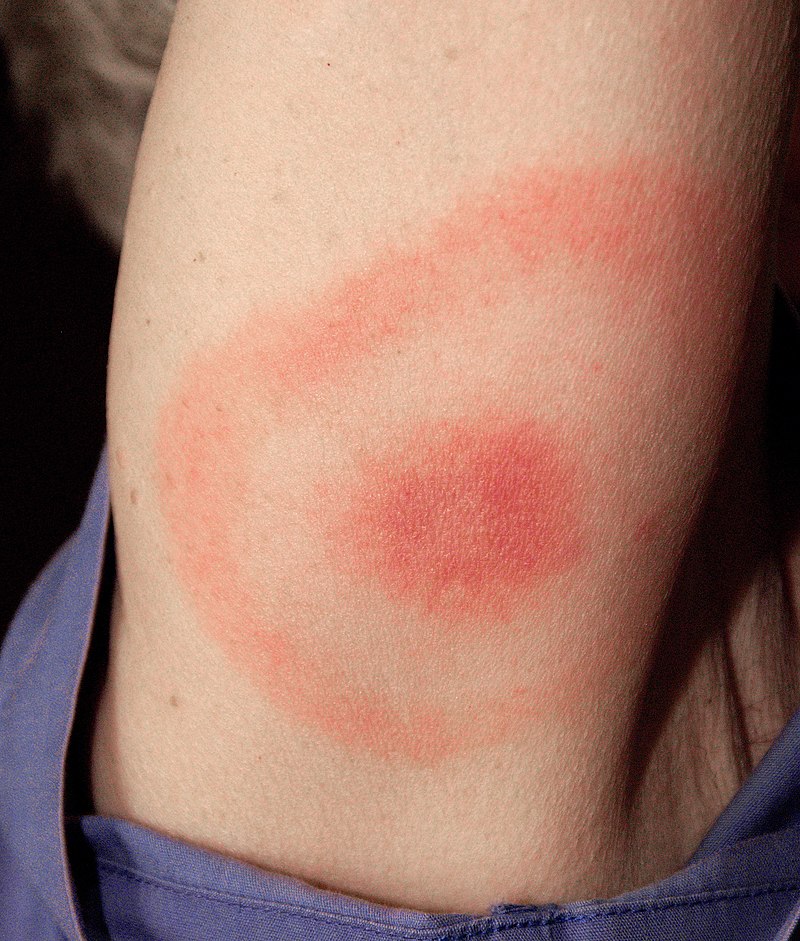
A 12-year-old boy who recently emigrated from Pakistan presents with fever, muscle pain, and weakness of the trunk, abdomen, and legs. The patient’s mother says that he has not been vaccinated. Physical examination reveals fasciculation and flaccid paralysis of the lower limbs. A CSF analysis reveals lymphocytosis with normal glucose and protein levels. A throat swab reveals an RNA virus. Which of the following would most likely be destroyed by the virus in this patient?
A. Basal ganglia
B. Posterior horn cells of the spinal cord
C. Myelin sheath of neurons
D. Muscle cells
E. Anterior horn of the spinal cord
A 2-year-old girl is brought to the doctor by her mother with persistent scratching of her perianal region. The patient’s mother says that symptoms started 3 days ago and have progressively worsened until she is nearly continuously scratching even in public places. She says that the scratching is worse at night and disturbs her sleep. An anal swab and staining with lactophenol cotton blue reveal findings in the image (see image). Which of the following is the organism most likely responsible for this patient’s condition?
A. Enterobius vermicularis
B. Wuchereria bancrofti
C. Taenia saginata
D. Ancylostoma duodenale
E. Ascaris lumbricoides
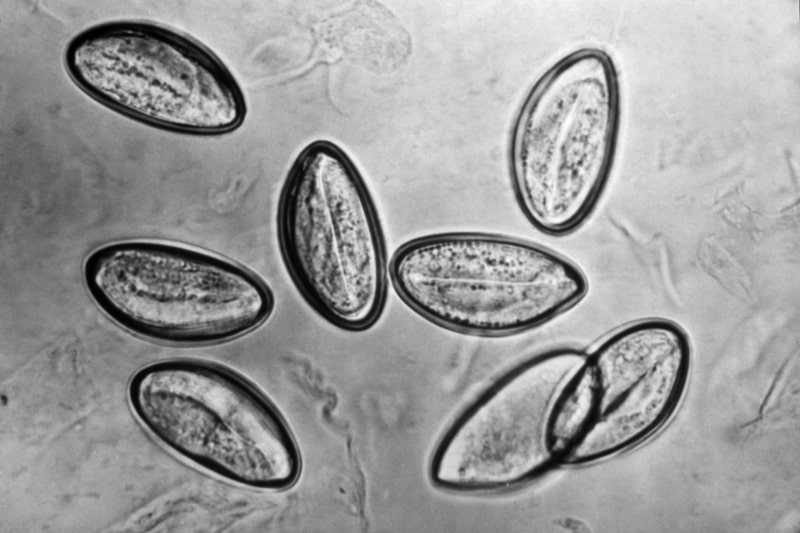
A 19-year-old woman presents to the emergency department with complaints of blurry vision and headaches that started 2 days ago. She reports that she has been experiencing some facial pain, but she thought it was related to her toothache. She is also worried about a black spot that is increasing in size on her face over the last month. She expresses concerns about her frequency of urination. Recently, she had a runny nose and cough that resolved spontaneously. The patient was diagnosed with type 1 diabetes mellitus at 13 years of age. She is a non-smoker and drinks beer occasionally. Her blood pressure is 122/98 mm Hg and the temperature is 37.2°C (98.9°F). The physical examination is normal with the exception of a black necrotic eschar lateral to the right nasal ala. She lost 2.7 kg (6 lb) since her last visit, which was 6 months ago. A routine urinalysis at the office is positive for glucose and ketones. What is the most likely cause of the patient’s symptoms?
A. Bacillus anthracis
B. Mucormycosis
C. Histoplasma capsulatum
D. Aspergillus fumigatus
E. Clostridium difficile
A 48-year-old woman who lives in Ohio presents to her physician several weeks after she sustained an injury in which a small rock hit her right leg while mowing the lawn. A raised, crusted, verrucous skin lesion appeared on the affected limb 2 weeks later with focal lymphangitis. The lesion is irregular with sharp borders and overlies a subcutaneous abscess. She denies fevers, chills, breathing issues, or musculoskeletal pain. Due to the appearance of the lesion, the physician initially suspected squamous cell carcinoma. He referred the patient to a dermatology clinic where a biopsy was obtained. Histologic specimens after staining with hematoxylin and eosin (H&E (image 1)) and a special Grocott-Gomori methenamine silver nitrate (GMS) stain (image 2) are shown. Which of the following is the most likely diagnosis?
A. Squamous cell carcinoma
B. Blastomycosis
C. Basal cell carcinoma
D. Sporotrichosis
E. Giant keratoacanthoma

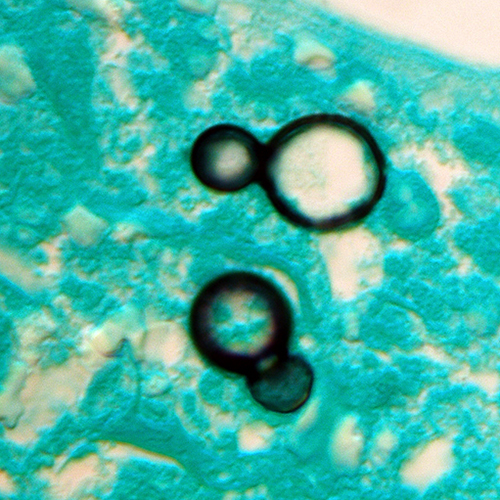
A 6-month-old girl has a weak cry, poor suck, ptosis, and constipation. Her condition began 2 days ago with a single episode of abundant watery stool and elevated temperature. The child was born at term to a healthy 26-year-old mother with an uneventful antenatal course and puerperium. The infant was exclusively breastfed till 5 months of age, after which she began receiving grated potatoes, pumpkin, carrots, and apples, in addition to the breastfeeding. She does not receive any fluids other than breast milk. The last new food item to be introduced was homemade honey that her mother added several times to grated sour apples as a sweetener 2 weeks before the onset of symptoms. The vital signs are as follows: blood pressure 70/40 mm Hg, heart rate 98/min, respiratory rate 29/min, and temperature 36.4°C (98.2°F). On physical examination, she is lethargic and has poor head control. A neurologic examination reveals ptosis and facial muscle weakness, widespread hypotonia, and symmetrically decreased upper and lower extremity reflexes. Which of the following options is a part of the pathogenesis underlying the patient’s condition?
A. Hypocalcemia due to a decrease in breast milk consumption
B. Hyperkalemia due to increased dietary intake
C. Vegetative form of Clostridium botulinum spores in the patient’s colon
D. Dehydration due to the absence of additional fluid intake
E. Development of antibodies against the acetylcholine receptor
A 4-year-old boy presents with 3 days of fever, crampy abdominal pain, vomiting, and loose, bloody bowel movements containing mucus. The patient’s mother says that other children from his daycare class have also developed similar symptoms. The patient’s temperature is 39.0°C (102.2°F). On physical examination, the patient is irritable and inconsolable, and his abdomen is distended. Intravenous fluid resuscitation is initiated. Histopathologic analysis of his stool reveals numerous red and white blood cells. Which of the following is characteristic of the most likely microorganism responsible for this patient’s symptoms?
A. Inactivation of elongation factor EF-2
B. Inactivation of the 60S ribosome subunit
C. Permanent activation of Gs alpha subunit
D. Overactivation of guanylate cyclase
E. Disabling Gi alpha subunit
A 21-year-old man seeks evaluation at an urgent care clinic because of nausea, vomiting, and abdominal pain that began 2 hours ago. He attended a picnic this afternoon, where he ate a cheese sandwich and potato salad. He says that a number of his friends who were at the picnic have similar symptoms. His medical history is significant for celiac disease, which is well-controlled with a gluten-free diet, and an appendectomy that was performed last year. Vital signs include: temperature of 37.0°C (98.6°F), respiratory rate 15/min, pulse 97/min, and blood pressure 98/78 mm Hg. He is started on intravenous fluids. Which of the following is the most likely cause of this patient’s condition?
A. A toxin produced by a gram-positive, catalase-positive bacteria
B. Antigliadin antibody
C. Gram-negative bacillus
D. Gram-positive, catalase-negative bacteria
E. Gram-positive, catalase-positive bacteria
A 5-year-old child is brought to a pediatric clinic by his mother for a rash that started a few days ago. The mother adds that her son has also had a fever and sore throat since last week. His immunizations are up to date. On examination, a rash is present over the trunk and upper extremities and feels like sandpaper to touch. An oropharyngeal examination is suggestive of exudative pharyngitis with a white coat over the tongue. The physician swabs the throat and uses the swab in a rapid antigen detection test kit. He also sends the sample for microbiological culture. The physician then recommends empiric antibiotic therapy and tells the mother that if the boy is left untreated, the likelihood of developing a complication later in life is very high. Which of the following best explains the mechanism underlying the development of the complication the physician is talking about?
A. Antigenic shift
B. Bacterial tissue invasion
C. Molecular mimicry
D. Toxin-mediated cellular damage
E. Genetic drift
A 58-year-old man presents with a high-grade fever, throbbing left-sided headache, vision loss, and left orbital pain. He says that his symptoms started acutely 2 days ago with painful left-sided mid-facial swelling and a rash, which progressively worsened. Today, he woke up with complete vision loss in his left eye. His past medical history is significant for type 2 diabetes mellitus, diagnosed 5 years ago. He was started on an oral hypoglycemic agent which he discontinued after a year. His temperature is 38.9°C (102.0°F), the blood pressure is 120/80 mm Hg, the pulse is 120/min, and the respiratory rate is 20/min. On examination, there is purulent discharge from the left eye and swelling of the left half of his face including the orbit. Oral examination reveals extensive necrosis of the palate with a black necrotic eschar and purulent discharge. Ophthalmic examination is significant for left-sided ptosis, proptosis, and an absence of the pupillary light reflex. Laboratory findings are significant for a blood glucose level of 388 mg/dL and a white blood cell count of 19,000 cells/mm³. Urinary ketone bodies are positive. Fungal elements are found on a KOH mount of the discharge. Which of the following statements best describes the organism responsible for this patient’s condition?
A. It produces conidiospores
B. It appears as a narrow-based budding yeast with a thick capsule
C. It has budding and filamentous forms
D. Histopathological examination shows non-septate branching hyphae
E. Histopathological examination shows acute angle branching hyphae
A 24-year-old woman presents with fever, abdominal pain, and bloody bowel movements. She says her symptoms onset 2 days ago and have not improved. She describes the abdominal pain as moderate, cramping in character, and poorly localized. 1 week ago, she says she was on a camping trip with her friends and had barbecued chicken which she thought tasted strange. The patient denies any chills, hemoptysis, hematochezia, or similar symptoms in the past. The vital signs include: pulse 87/min and temperature 37.8°C (100.0°F). Physical examination is significant for moderate tenderness to palpation in the periumbilical region with no rebound or guarding. Stool is guaiac positive. Which of the following is a complication associated with this patient’s most likely diagnosis?
A. Typhoid
B. Appendicitis
C. Toxic megacolon
D. Guillain-Barré syndrome
E. Hemolytic uremic syndrome
Do you want to practice more Microbiology questions?
Create a free Lecturio account and you’ll have access to the Lecturio question bank with more than 2,200 USMLE Step 1 practice questions.
